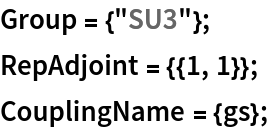Wolfram Language Paclet Repository
Community-contributed installable additions to the Wolfram Language
Computes 2-to-2 scattering matrix amplitudes for arbitrary quantum field theories
Contributed by: Andreas Ekstedt
Oliver Gould
Joonas Hirvonen
Benoit Laurent
Lauri Niemi
Philipp Schicho
Jorinde van de Vis
Computes 2-to-2 scattering matrix amplitudes for arbitrary quantum field theories.

To install this paclet in your Wolfram Language environment,
evaluate this code:
PacletInstall["WallGo/WallGoMatrix"]
To load the code after installation, evaluate this code:
Needs["WallGo`WallGoMatrix`"]
Using SU(3) in the representation with Dynkin index {1,1} and representation R= 8.
| In[1]:= |  |
No scalars are present in the theory:
| In[2]:= |
Fermions are implemented as Weyl spinors. Therefore, to create one Dirac fermion, one left-handed and one right-handed fermion is needed:
| In[3]:= |  |
For QCD, Nf=6 fermions are needed:
| In[4]:= | ![RepFermion3Gen = {RepFermion1Gen, RepFermion1Gen, RepFermion1Gen, RepFermion1Gen, RepFermion1Gen, RepFermion1Gen} // Flatten[#, 1] &;](https://www.wolframcloud.com/obj/resourcesystem/images/c2d/c2d03976-f5c0-4c58-a9fc-287fdf2643fc/0-2-1/6c655b9404225a5f.png) |
The input for the gauge interactions to DRalgo are then given by
| In[5]:= |
To invoke the model, it needs to be imported:
| In[6]:= |
Representation for top quark:
| In[7]:= |
| Out[7]= |
Representation for gluon:
| In[8]:= |
| Out[8]= |
Representation for 5 light quarks:
| In[9]:= |
| Out[9]= |
Collecting out-of-equilibrium particles:
| In[10]:= |
Collecting light particles (these are never incoming):
| In[11]:= |
| In[12]:= | ![OutputFile = "matrixElements.qcd";
MatrixElements = ExportMatrixElements[
OutputFile,
ParticleList,
LightParticleList,
{
TruncateAtLeadingLog -> True,
Format -> {"json", "txt"}}]](https://www.wolframcloud.com/obj/resourcesystem/images/c2d/c2d03976-f5c0-4c58-a9fc-287fdf2643fc/0-2-1/63263e96f87f17e7.png) |
| Out[8]= |  |
Wolfram Language Version 13
GNU General Public License v3.0 or later